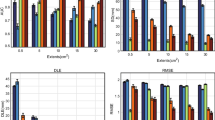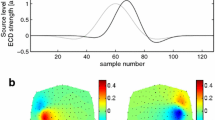Abstract
In this work, we propose a spatial-temporal two-way regularized regression method for reconstructing neural source signals from EEG/MEG time course measurements. The proposed method estimates the dipole locations and amplitudes simultaneously through minimizing a single penalized least squares criterion. The novelty of our methodology is the simultaneous consideration of three desirable properties of the reconstructed source signals, that is, spatial focality, spatial smoothness, and temporal smoothness. The desirable properties are achieved by using three separate penalty functions in the penalized regression framework. Specifically, we impose a roughness penalty in the temporal domain for temporal smoothness, and a sparsity-inducing penalty and a graph Laplacian penalty in the spatial domain for spatial focality and smoothness. We develop a computational efficient multilevel block coordinate descent algorithm to implement the method. Using a simulation study with several settings of different spatial complexity and two real MEG examples, we show that the proposed method outperforms existing methods that use only a subset of the three penalty functions.







Similar content being viewed by others
References
Adde, G., Clerc, M., Keriven, R. (2005). Imaging methods for MEG/EEG inverse problem. In In proceedings of joint meeting of 5th international conference on bioelectromagnetism and 5th international symposium on noninvasive functional source imaging (Vol. 7, pp. 111–114).
Auranen, T., Nummenmaa, A., Hämäläinen, M.S., Jääskeläinen, I.P., Lampinen, J., Vehtari, A., et al. (2005). Bayesian analysis of the neuromagnetic inverse problem with lp-norm priors. NeuroImage, 26(3), 870–884.
Baillet, S., & Garnero, L. (1997). A bayesian approach to introducing anatomo-functional prior in the EEG/MEG inverse problem. IEEE Transactions on Biomedical Engineering, 44(5), 374–385.
Belkin, M., & Niyogi, P. (2003). Laplacian eigenmaps for dimensionality reduction and data representation. Neural Computation, 15(6), 1373–1396.
Bolstad, A., Veen, B.V., Nowak, R. (2009). Space-time event sparse penalization for magneto-/electroencephalography. NeuroImage, 46(4), 1066–1081.
Brent, R. (1973). Algorithms for minimization without derivatives. Englewood Cliffs: Prentice-Hall.
Castillo, E.M., Simos, P.G., Wheless, J.W., Baumgartner, J.E., Breier, J.I., Billingsley, R.L., Sarkari, S., Fitzgerald, M.E., Papanicolaou, A.C. (2004). Integrating sensory and motor mapping in a comprehensive MEG protocol: clinical validity and replicability. NeuroImage, 21, 973–983.
Cohen, D. (1968). Magnetoencephalography: evidence of magnetic fields produced by alpha rhythm currents. Science, 161, 784–786.
Cvetković, D.M., Doob, M., Sachs, H. (1998). Spectra of graphs: theory and applications, 3rd edn. New York: Wiley.
Darvas, F., Pantazis, D., Kucukaltun-Yildirim, E., Leahy, R. (2004). Mapping human brain function with MEG and EEG: methods and validation. NeoroImage, 23, 289–299.
Daunizeau, J., Mattout, J., Clonda, D., Goulard, B., Benali, H., Lina, J.-M. (2006). Bayesian spatio-temporal approach for EEG source reconstruction: conciliating ECD and distributed models. IEEE Transactions on Biomedical Engineering, 53(3), 503–516.
Ding, L., & He, B. (2008). Sparse source imaging in EEG with accurate field modeling. Human Brain Mapping, 29(9), 1053–1067.
Dogandžić, A., & Nehorai, A. (2000). Estimating evoked dipole responses in unknown spatially correlated noise with EEG/MEG arrays. IEEE Transactions on Signal Processing, 48(1), 13–25.
Friston, K., Harrison, L., Daunizeau, J., Kiebel, S., Phillips, C., Trujillo-Barreto, N., et al. (2008). Multiple sparse priors for the M/EEG inverse problem. NeuroImage, 39(3), 1104–1120.
Gorodnitsky, I.F., & Rao, B.D. (1997). Sparse signal reconstruction from limited data using FOCUSS: a re-weighted minimum norm algorithm. Signal Processing, IEEE Transactions on, 45(3), 600–616.
Gramfort, A., Kowalski, M., Hämäläinen, M. (2012). Mixed-norm estimates for the M/EEG inverse problem using accelerated gradient methods. Physics in Medicine and Biology, 57(7), 1937–1961.
Green, P.J., & Silverman, B.W. (1994). Nonparametric regression and generalized linear models: a roughness penalty approach. Boca Raton: CRC Press.
Hämäläinen, M., & Ilmoniemi, R.J. (1994). Interpreting magnetic fields of the brain: minimum norm estimates. Medical and Biological Engineering and Computing, 32(1), 35–42.
Hämäläinen, M., Hari, R., Ilmoniemi, R.J., Knuutila, J., Lounasmaa, O.V. (1993). Magnetoencephalography-theory, instrumentation, and applications to noninvasive studies of the working human brain. Reviews of Modern Physics, 65(2), 413–497.
Hastie, T., & Tibshirani, R. (1990). Generalized additive models. New York: Chapman and Hall.
Haufe, S., Nikulin, V.V., Ziehe, A., Müller, K.R., Nolte, G. (2008). Combining sparsity and rotational invariance in EEG/MEG source reconstruction. NeuroImage, 2(42), 726–738.
Jeffs, B., Leahy, R., Singh, M. (1987). An evaluation of methods for neuromagnetic image reconstruction. IEEE Transactions on Biomedical Engineering, 34, 713–723.
Jun, S.C., George, J.S., Paŕe-Blagoev, J., Plis, S.M., Ranken, D.M., Schmidt, D.M., Wood, C.C. (2005). Spatiotemporal bayesian inference dipole analysis for MEG neuroimaging data. NeuroImage, 29(1), 84–98.
Li, C., & Li, H. (2010). Variable selection and regression analysis for graph-structured covariates with an application to genomics. Annals of Applied Statistics, 4(3), 1498–1516.
Lin, F.-H., Belliveau, J.W., Dale, A.M., Hämäläinen, M.S. (2006). Distributed current estimates using cortical orientation constraints. Human Brain Mapping, 27, 1–13.
Matsuura, K., & Okabe, Y. (1995). Selective minimum-norm solution of the biomagnetic inverse problem. IEEE Transactions on Biomedical Engineering, 42, 608–615.
Mosher, J., Lewis, P., Leahy, R. (1992). Multiple dipole modeling and localization from spatio-temporal MEG data. IEEE Transactions on Biomedical Engineering, 39(6), 541–557.
Mosher, J.C., Leahy, R.M., Lewis, P.S. (1999). EEG and MEG: forward solutions for inverse methods. IEEE Transactions on Biomedical Engineering, 46(3), 245–259.
Mukherjee, A., Chen, K., Wang, N., Zhu, J. (2013). On the degrees of freedom of reduced-rank estimators in multivariate regression. unver review. Available at http://arxiv.org/pdf/1210.2464.pdf.
Nummenmaa, A., Auranen, T., Hämäläinen, M.S., Jääskeläinen, I.P., Lampinen, J., Sams, M., Vehtari, A. (2007). Hierarchical bayesian estimates of distributed MEG sources: theoretical aspects and comparison of variational and MCMC methods. NeuroImage, 35(2), 669–685.
Ou, W., Hämäläinen, M., Golland, P. (2009). A distributed spatio-temporal EEG/MEG inverse solver. NeuroImage, 44(3), 932–46.
Papanicolaou, A. (1995). An introduction to magnetoencephalography with some applications. Brain and Cognition, 27(3), 331–352.
Pascual-Marqui, R.D. (1999). Review of methods for solving the EEG inverse problem. International Journal of Bioelectromagnetism, 1, 75–86.
Pascual-Marqui, R.D. (2002). Standardized low-resolution brain electromagnetic tomography (sLORETA): technical details. Methods & Findings in Experimental & Clinical Pharmacology, 24(1), 5–12.
Pascual-Marqui, R.D., Michel, C.M., Lehmann, D. (1994). Low resolution electromagnetic tomography: a new method for localizing electrical activity in the brain. International Journal of Psychophysiology, 18, 49–65.
R Development Core Team (2011). R: a language and environment for statistical computing. Vienna, Austria: R Foundation for Statistical Computing. ISBN 3-900051-07-0.
Scherg, M., & von Cramon, D. (1986). Evoked dipole source potentials of the human auditory cortex. Electroencephalography and clinical neurophysiology, 65, 344–360.
Schmidt, R. (1986). Multiple emitter location and signal parameter estimation. IEEE Transactions on Antennas and Propagation, 43(3), 276–280.
Sorrentino, A., Johansen, A., Aston, J., Nichols, T., Kendall, W. (2012). Dynamic filtering of static dipoles in magnetoencephalography. Arxiv preprint arXiv:1205.6310.
Tenenbaum, J.B., de Silva, V., Langford, J.C. (2000). A global geometric framework for nonlinear dimensionality reduction. Science, 290, 2319–2323.
Tian, T.S., & Li, Z. (2011). A spatio-temporal solution for the EEG/MEG inverse problem using group penalization methods. Statistics and Its Interface, 4(4), 521–534.
Tian, T.S., Huang, J.Z., Shen, H., Li, Z. (2012). A two-way regularization method for EEG/MEG source reconstruction. Annals of Applied Statistics, 6(3), 1021–1046.
Tibshirani, R. (1996). Regression shrinkage and selection via the lasso. Journal of the Royal Statistical Society: Series B, 58, 267–288.
Trujillo-Barreto, N., Aubert-Vázquez, E., Penny, W. (2008). Bayesian m/eeg source reconstruction with spatio-temporal priors. NeuroImage, 39(1), 318–335.
Tseng, P. (2001). Convergence of block coordinate descent method for nondifferentiable maximization. Journal of Optimization Theory and Applications, 109(3), 475–494.
Uutela, K., Hämäläinen, M., Somersalo, E. (1999). Visualization of magnetoencephalographic data using minimum current estimates. NeuroImage, 10, 173–180.
Valdés-Sosa, P., Vega-Hernández, M., Sánchez-Bornot, J., Martínez-Montes, E., Bobes, M. (2009). EEG source imaging with spatio-temporal tomographic nonnegative independent component analysis. Human Brain Mapping, 30, 1898–1910.
Van Veen, B.D., & Buckley, K.M. (1988). Beamforming: a versatile approach to spatial filtering. IEEE ASSP Magazine, 5, 4–24.
Van Veen, B.D., van Drongelen, W., Yuchtman, M., Suzuki, A. (1997). Localization of brain electrical activity via linearly constrained minimum variance spatial filtering. IEEE Transactions on Biomedical Engineering, 44, 867–880.
Yamazaki, T., Kamijo, K., Kenmochi, A., Fukuzumi, S., Kiyuna, T., Takaki, Y., Kuroiwa, Y. (2000). Multiple equivalent current dipole source localization of visual event-related potentials during oddball paradigm with motor response. Brain Topography, 12, 159–175.
Acknowledgments
This work is supported in part by NIDA (1 RC1 DA029425-01), NSF (DMS-09-07170, DMS-10-07618, CMMI-0800575, DMS-11-06912, DMS-12-08952, and DMS-12-08786), and King Abdullah University of Science and Technology (KUS-CI-016-04).
Author information
Authors and Affiliations
Corresponding author
Rights and permissions
About this article
Cite this article
Tian, T.S., Huang, J.Z., Shen, H. et al. EEG/MEG Source Reconstruction with Spatial-Temporal Two-Way Regularized Regression. Neuroinform 11, 477–493 (2013). https://doi.org/10.1007/s12021-013-9193-2
Published:
Issue Date:
DOI: https://doi.org/10.1007/s12021-013-9193-2




